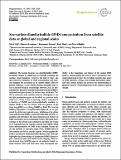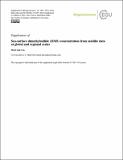Por favor, use este identificador para citar o enlazar a este item:
http://hdl.handle.net/10261/172890COMPARTIR / EXPORTAR:
 SHARE SHARE
 CORE
BASE CORE
BASE
|
|
| Visualizar otros formatos: MARC | Dublin Core | RDF | ORE | MODS | METS | DIDL | DATACITE | |

| Título: | Sea-surface dimethylsulfide (DMS) concentration from satellite data at global and regional scales |
Autor: | Galí, Martí CSIC ORCID; Levasseur, Maurice; Devred, Emmanuel; Simó, Rafel CSIC ORCID ; Babin, Marcel | Fecha de publicación: | jun-2018 | Editor: | European Geosciences Union | Citación: | Biogeosciences 15: 3497-3519 (2018) | Resumen: | The marine biogenic gas dimethylsulfide (DMS) modulates climate by enhancing aerosol light scattering and seeding cloud formation. However, the lack of time-and space-resolved estimates of DMS concentration and emission hampers the assessment of its climatic effects. Here we present DMSSAT, a new remote sensing algorithm that relies on macroecological relationships between DMS, its phytoplanktonic precursor dimethylsulfoniopropionate (DMSPt) and plankton light exposure. In the first step, planktonic DMSPt is estimated from satellite-retrieved chlorophyll a and the light penetration regime as described in a previous study (Galí et al., 2015). In the second step, DMS is estimated as a function of DMSPt and photosynthetically available radiation (PAR) at the sea surface with an equation of the form: log10DMS Combining double low line α + βlog10DMSPt + 3PAR. The two-step DMSSAT algorithm is computationally light and can be optimized for global and regional scales. Validation at the global scale indicates that DMSSAT has better skill than previous algorithms and reproduces the main climatological features of DMS seasonality across contrasting biomes. The main shortcomings of the global-scale optimized algorithm are related to (i) regional biases in remotely sensed chlorophyll (which cause underestimation of DMS in the Southern Ocean) and (ii) the inability to reproduce high DMS • DMSPt ratios in late summer and fall in specific regions (which suggests the need to account for additional DMS drivers). Our work also highlights the shortcomings of interpolated DMS climatologies, caused by sparse and biased in situ sampling. Time series derived from MODIS-Aqua in the subpolar North Atlantic between 2003 and 2016 show wide interannual variability in the magnitude and timing of the annual DMS peak(s), demonstrating the need to move beyond the classical climatological view. By providing synoptic time series of DMS emission, DMSSAT can leverage atmospheric chemistry and climate models and advance our understanding of plankton-aerosol-cloud interactions in the context of global change | Descripción: | 23 pages, 9 figures, 4 tables, 1 appendix, supplementary material https://doi.org/10.5194/bg-15-3497-2018-supplement | Versión del editor: | https://dx.doi.org/10.5194/bg-15-3497-2018 | URI: | http://hdl.handle.net/10261/172890 | DOI: | 10.5194/bg-15-3497-2018 | Identificadores: | doi: 10.5194/bg-15-3497-2018 issn: 1726-4170 e-issn: 1726-4189 |
| Aparece en las colecciones: | (ICM) Artículos |
Ficheros en este ítem:
| Fichero | Descripción | Tamaño | Formato | |
|---|---|---|---|---|
| Gali_et_al_2018.pdf | 1,72 MB | Adobe PDF |  Visualizar/Abrir | |
| Gali_et_al_2018_suppl.pdf | 3,58 MB | Adobe PDF |  Visualizar/Abrir |
CORE Recommender
SCOPUSTM
Citations
53
checked on 22-abr-2024
WEB OF SCIENCETM
Citations
46
checked on 17-feb-2024
Page view(s)
321
checked on 23-abr-2024
Download(s)
381
checked on 23-abr-2024
Google ScholarTM
Check
Altmetric
Altmetric
Este item está licenciado bajo una Licencia Creative Commons

